I recently visited the Isle of Man which I discovered is the only whole nation to be a member of the UNESCO world network of Biosphere Reserves. This got me thinking about other lesser-known UNESCO sites in Europe that are off the beaten track. I reached out to some of my fellow bloggers and the result is this post:
What you can expect in this post:
*This site uses affiliate links and I may earn a small commission when you use my links and make a purchase without incurring an additional fee yourself.
Thank you for supporting this website. See my disclaimer page for more details.
Lesser known UNESCO sites in Europe
Upper Svaneti, Georgia
by Emily from Wander Lush

Shielded throughout most of history by the almost-impenetrable Greater Caucasus mountains, Upper Svaneti in remote Republic of Georgia is one of the world’s most intriguing UNESCO sites.
Svaneti is well known within the region. Most visitors to Georgia spend a few days in the area’s biggest town, Mestia, and use it as a base for trekking. But outside of the Caucasus, not many people are familiar with Upper Svaneti. If you’re anything like me, the moment you lay eyes on this landscape, it will go down as one of your best travel days of all time.
UNESCO inscribed Upper Svaneti in 1996 in recognition of both its medieval architecture and the breathtaking mountains that serve as a backdrop. The village of Chazhashi in Ushguli, about a 3-hour drive from Mestia, gets a special mention for its defensive tower houses. Once used by local families as fortified dwellings, there are more than 200 stone towers still standing today. The area’s traditional inhabitants, the Svans, were renowned fighters and have a fascinating history. Before you visit Upper Svaneti, it’s a good idea to learn a bit about their culture and cuisine at the Ethnography Museum in Mestia.
It’s free to visit Ushguli and wander around the villages at your leisure. There are guesthouses and restaurants in a few of the villages, making it possible to stay overnight. Most people, however, choose to visit as a day trip from Mestia. A spot in a shared van should cost around 20 GEL (10 USD).
Torre de Hercules in A Coruña, Spain
by Teresa from Brogan Abroad

The Torre de Hercules (or Hercules’ Tower) is an ancient lighthouse located in A Coruña, in Northern Spain. Records of its existence go back to the 2nd century, when it was built, maybe even rebuilt, by the Romans under Emperor Trajan. It is the oldest working lighthouse in the world and a UNESCO World Heritage Site since 2007.
But it doesn’t look like it’s almost 2,000 years old. It was, in fact, majorly modified in the 17thand 18th centuries and it has recently undergone a restoration program.
You will find the Torre de Hercules perched on a promontory, overlooking the Atlantic Ocean. A walk to the lighthouse is a must do in A Coruña. This walk will take you along the promenade to a small peninsula just off the city centre, where you will be greeted by this majestic sight. The dramatic coastline around it with the waves crushing against it, and the typically inclement weather of the area adds a bit of mysticism to the lighthouse, and it’s guarantee to take your breath away.
This mysticism also comes from the legend of Brogan (or Breogán), a significant figure in local culture. Brogan was the Celtic King said to have founded the kingdom of Galicia, the region in the north west of Spain where A Coruña is. Legend has it that Brogan built a tower so tall that you were able to see what is now Ireland on the horizon. This tower could perhaps be the Torre de Hercules, although there is no evidence of this or even of Brogan’s existence. Plus you would have had to have incredible long distance eyesight to see Ireland! I like the story, so I like to think it was true.
Nessebar, Bulgaria
by Cora from Inside our Suitcase

Situated just metres from the popular tourist destination of Sunny Beach, Bulgaria is the less well known Nessebar Town which has been on the UNESCO World Heritage List since 1983. Nessebar is more than 3,000 years old and was originally a Thracian (Indo-European tribe) settlement.
Many people visit Nessebar on a day trip from Sunny Beach or the surrounding areas, however, there are a couple of hotels just outside of the Nessebar border that I’d recommend staying at instead; Sol Nessebar Bay is a great example.
Take a stroll through the town to the coastal edge of the Black Sea and you’ll find a number of traditional restaurants where you can sit, dine and take in the incredible views out to the ocean. Picking up traditional Bulgarian gifts and souvenirs such as; rose oil, pottery, lavender and acrylic signage on your way back to the entrance.
We loved visiting Nessebar as it’s a very affordable European UNESCO site to visit, with zero entrance fees to the town itself and just €1 or €2 to visit any of the museums to learn more about the town’s history. You can experience everything this town has to offer without breaking the bank.
Mtskheta, Georgia
by Maggie from World was Here First

Though it’s located only about 15 kilometres from Tbilisi and is one of the most popular day trips from and places to visit in the Georgian capital, the beautiful town of Mtskheta is still an underrated UNESCO site compared to many others in Europe.
Mtskheta sits on the confluence of the Mtkvari and Aragvi rivers and its collection of religious sites and buildings together were inscribed on the UNESCO World Heritage list in 1994. Mtskheta was once the capital of Georgia and is the place where Christianity was established in the Caucasian nation. As Georgia was only the second country in the world to adopt Christianity as a state religion (the first was neighbouring Armenia), this makes Mtskheta an incredibly important town to the history of the country. Today, it is still the home of the Georgian Orthodox Church and a place of pilgrimage for many religious Georgians.
Mtskheta is a small town that can be seen in the span of a couple of hours. There are numerous churches and monasteries that are worth visiting, however, the most famous would be the Jvari Monastery, which is located on a hilltop overlooking the town. It is necessary to take a taxi up to visit the monastery as the road reaching it is winding and it can take about 15 minutes to reach it from the city centre. Taxis should only cost around 15 GEL (about $5 USD) and the driver will wait for you while you explore the church.
Though small in size, Mtskheta is an incredibly beautiful, historic, and underrated UNESCO World Heritage site that should absolutely be on your list.
Porto, Portugal
by Inma from A World to Travel
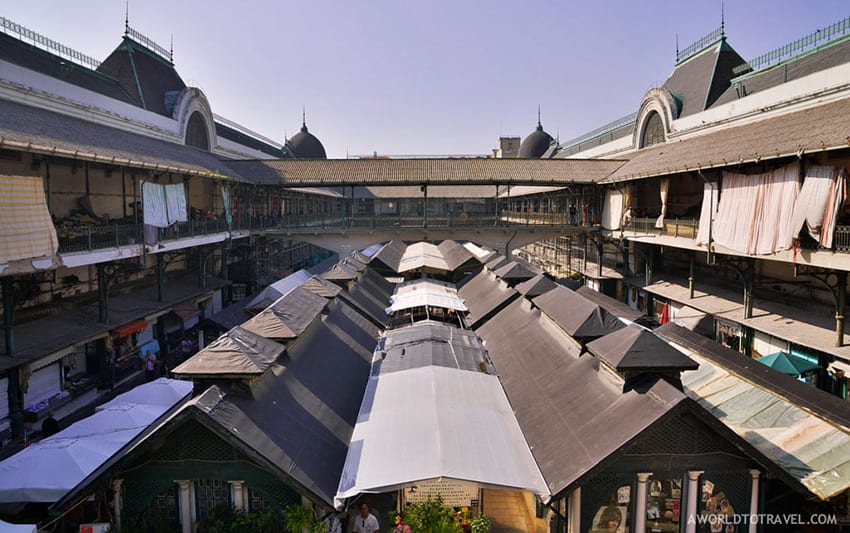
A great witness of the urban and architectural development of this city in the last 1000 years, the historic centre of Porto along with the Luiz I Bridge and Monastery of Serra do Pilar were inscribed on The List of World Heritage Sites by Unesco in 1996; long before the city suffered the effects of the social media boom and the incessant search for places with enough potential for Instagram.
To admire its beauty as a whole, it is enough to cross the aforementioned bridge and stroll along the other bank of the Douro River. Also, a very respectable option is to do it from the top of the bridge (the sunset views from there are the best) or savouring a glass of sweet Port wine from one of its wineries.
After that, we strongly recommend exploring the historic neighbourhood in-depth, getting lost through its steep streets full of steps, its colourful single-family houses of up to three and four heights with clothes hanging on its balconies, and its numerous monumental ensembles that appear every bit between restaurants, neighbourhood shops and homes, among which the numerous churches and the famous cathedral stand out. You will have to rub shoulders with many tourists, but it will be worth it.
Here’s a complete Porto architecture guide to set you on the right foot. Enjoy!
San Cristóbal de La Laguna, Tenerife
by Abigail from Inside the Travel Lab.com
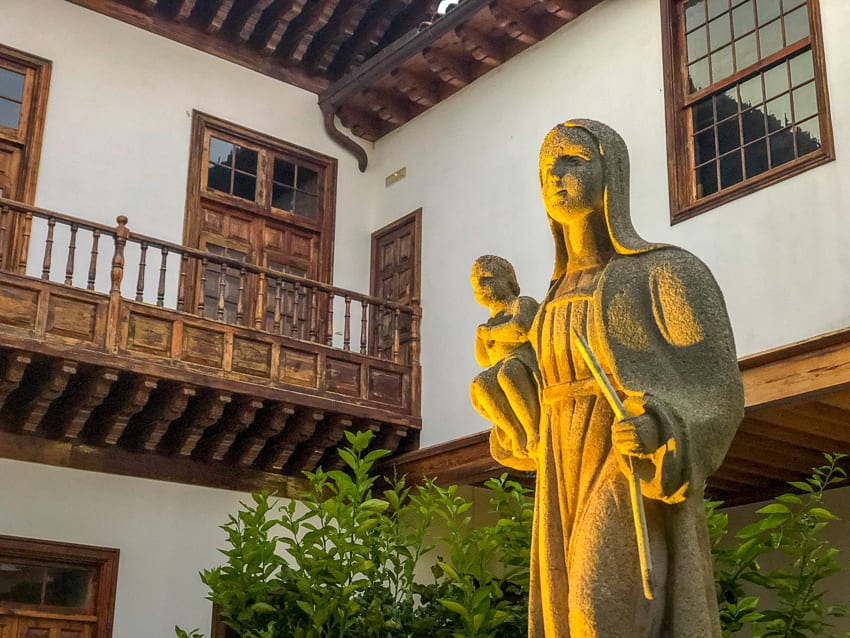
The volcanic island of Tenerife has won many accolades in its time. A UNESCO Biosphere here. El Teide National Park and UNESCO World Heritage Site there.
But my favourite by far is another one: San Cristóbal de La Laguna.
It’s a town, rather than a building, and as a result you can easily come and go as many times as you please.
San Cristóbal lives in the northern part of this Canary Island, away from the sea. Thus, it lacks the infamous tourist crowds that congest other playas and parts of the island.
The town itself dates back to the late 15th century, built on the plateau 550 metres above sea level. In the words of UNESCO itself, the town began “next to an insalubrious lagoon.” This is more important than it sounds as it helps to demarcate the two different parts of the town.
The Upper Town has an unplanned urban structure, the Lower Town lives on a grid.
Why does this matter?
It’s the first of its kind in the world: a town planned around a grid, the first ideal territory town designed along philosophical principles and according to state regulations.
Until then, everyone had kind of muddled along into the haphazard streets we see, most obviously, across the old towns of Europe.
From here, the grid was exported to the “New World” and now it’s seen as the obvious way to do things.
But for all this grid talk, San Cristóbal is a charming place. Of its 1470 or so buildings, 627 are conserved. Expect to see mudejar courtyards and fountains, powder blue walls, virgin statues, cobbled streets and plenty of lively tapas bars.
It’s free to wander around but some of the most historic buildings have strict opening times and fees to let you inside.
But for all its UNESCO World Heritage Site Status, San Cristobal is just a town looking for a visitor to come and enjoy her.
Monasteries of Batalha and Alcobaça, Portugal
by Cath from Passports and Adventures

Three UNESCO World Heritage sites that are probably less-well known but are easily visited are the monasteries of Batalha, Alcobaça and Tomar in Central Portugal. They form part of a heritage triangle in the region and are often enjoyed by many as part of a day trip from Lisbon.
During a trip exploring Central Portugal with kids, we visited two of the three in one day, and by accident. They were the monasteries of Batalha and Alcobaça. Along with the Convent of Christ in Tomar, these three UNESCO World Heritage sites are some of the most important monuments in Portugal.
The three towns of Alcobaça, Batalha and Tomar lie just 40 miles (or 65 kilometres) apart and are around an hour and a half from Lisbon. Hence, they are often enjoyed by many during one day from Lisbon. What makes these three monasteries a must-see is their stunning architecture.
Alcobaça is Portugal’s largest Gothic church and has a stunning façade. This church also holds the tombs of Dom Pedro and Dona Ines, tragic lovers whose tombs are magnificent.
Entry into the church is free but to see behind the scenes into the cloisters, dormitories and other areas such as the huge kitchen, you need to pay and entry fee which is worth it. You won’t be disappointed.
Batalha is another Gothic church and another with a stunning exterior. Again, entry into the main church is free but you should pay entry to the cloisters where you will be awed by the architecture, gardens and the Unfinished Chapel, an octagonal mausoleum.
Entry into the monasteries is €6 per adult, children under 12 are free. However, a Heritage Trail ticket costs just €15 and gives entry to all three sites and is valid for 7 days.
YOU MIGHT ALSO LIKE: UNESCO Sites Off the Beaten Track in the UK
Zamosc, Poland
by Karolina from Karolina Patryk

Zamosc, the Pearl of the Renaissance, is a prime tourist destination for travellers exploring Eastern Poland. A small town in Lublin Voivodeship, it was once one of the epicentres of the 16th century Polish-Lithuanian Commonwealth.
Bearing the features of an ideal town during the Renaissance, the beautiful and colourful buildings that can be found in Zamosc do not disappoint.
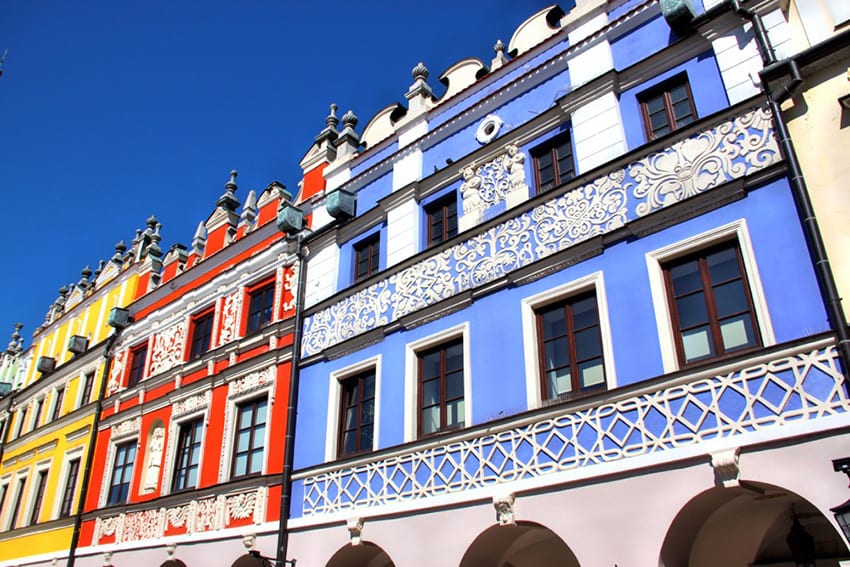
Begin your walk through the city in the Town Hall, Zamosc’s iconic structure with its looming 52-meter tower and the sweeping double staircase within the building. During the summer months, time your visit at noon to watch the trumpeter announce the hour at the top of the town hall. Observe the quirky gesture of sounding the trumpets towards only three directions, revealing an old grudge against Krakow.
Go through a time-lapse from the Renaissance to the Zamosc’s Russian era and the Second World War by visiting Zamosc’s Rotunda, a graveyard and memorial for the 45,000 victims of the war. At the end of your tour of Zamosc Old City, take a seat at one of the restaurants that line the square to see the Great Market’s transformation at night. The city is best visited during the Eurofolk Festival and the Zamosc Cultural Festival when the city is filled with lights, colour, and culture.
The most convenient way to get to Zamosc is by driving from Lublin on the E372. For public transportation, taking the train is recommended as it is the most straightforward. For those who are looking into flying there, the closest airport is near Lublin, which is around 40 kilometres away from Zamosc.
Alberobello, Italy
by Jeff from Our Passion for Travel

For travellers who get beyond the highlights of Rome, Florence and Venice, a real treat awaits you in the southern Italian region of Puglia. Aside from stunning beaches, this region also possesses its own unique architecture, particularly the homes known as trullis.
Trullis are easily identified with their white dry stone bases and pointy conical roofs and for having no windows. You can’t miss them if you try. These fairy tale homes are best observed by paying a visit to the UNESCO protected town of Alberobello.
In Alberobello, you’ll find row upon row of these quaint homes. Aside from admiring them from the outside, you can even step inside. You’ll need to watch your head as you enter, the small entries are a definitive hazard. Opposite the main centre of Alberobello, there is a wonderful vantage point where you can see the panorama of trulli homes here.
For those who a visit alone simply won’t do, some of the trullis even operate in a bed and breakfast arrangement.
Entry into Alberobello is free, and you’re able to wander around the town as you please. The town centre is a limited traffic zone and pedestrianised. On-street parking is located a 5-10 minute walk from the trulli homes.
Holy Trinity Columns, Olomouc, Czech Republic
by Veronika from Travel Geekery
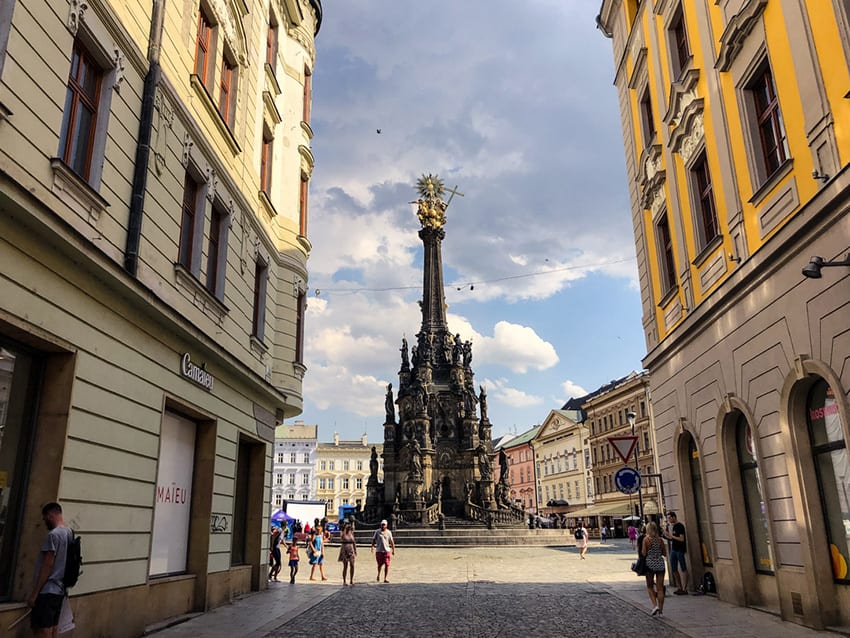
The whole historical center of Olomouc, the 6th largest city in the Czech Republic, should be on UNESCO. You’ll agree the moment you enter one of the two main squares – the Lower Square and the Upper one.
It’s right there on the Upper Square where you can find an unusually large Plague Column. It was built between 1716 and 1754, to celebrate the end of a 2-year long plague that swept through this part of Europe at the beginning of the 18th century.
It showed people’s unique standing by the Catholic Church and even strengthened the local patriotism, since all workers who participated in the construction were citizens of Olomouc.
The column is heavily decorated and represents the biggest group of baroque statues on one object in the whole of Central Europe. The masterpiece features 18 sculptures of saints, 12 light-bearer figures and 12 relief busts of the apostles. It’s then topped off with a sculptural group of the Assumption of Virgin Mary and the main Holy Trinity sculpture.
The size of the Trinity Column is unlike any you’ve ever seen. There’s even a small chapel located on the bottom.
If you look closely enough, you’ll notice a ‘golden’ cannonball in the structure. It’s there to remind that even the Holy Trinity Column wasn’t spared when the Prussian army surrounded the city.
The Holy Trinity Column was inscribed at the UNESCO World Heritage List in 2000.
Old Town Kotor, Montenegro
by Dhara from It’s Not About the Miles
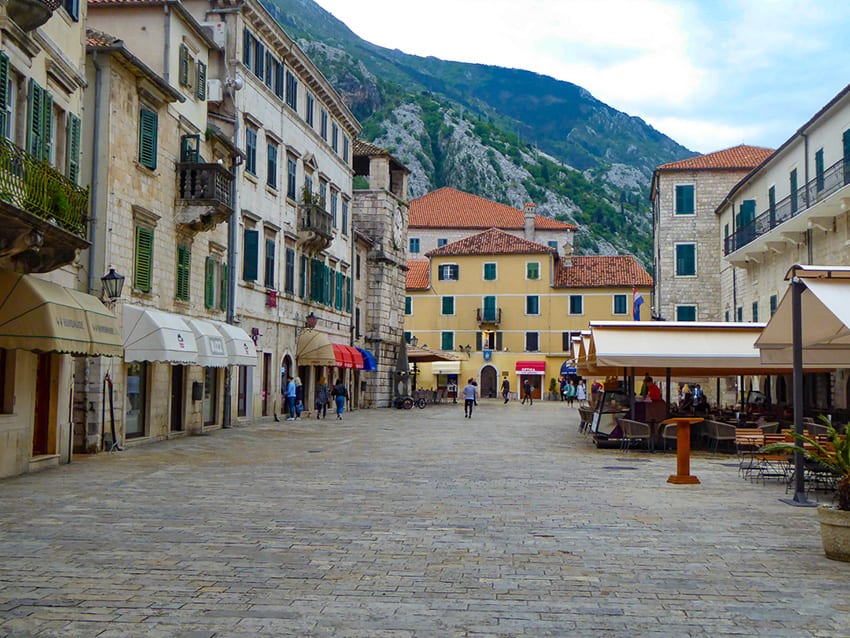
Old Town Kotor in Montenegro is a must-visit if you love history, culture, and cute cobblestone alleys. With a stunning location on a secluded portion of the Bay of Kotor, Old Town Kotor and the surrounding natural and region are designated a UNESCO World Heritage site.
There are lots of things to do in Kotor. But you can also make Kotor a base from which to explore the rest of Montenegro. The Old Town is a labyrinth of beautiful alleys, and lovely medieval palaces line the streets and squares. So wandering the streets of Kotor is a joy!
Kotor is surrounded by medieval town walls, built over centuries to protect the town from Ottoman attacks. You enter the town through one of several gates, of which the Sea Gate is the main one.
Climbing the walls to Kotor that lead up the hill to the Fort of St. John is a must-do activity when you visit, if you are in good shape. If you aren’t you can still climb the walls in town, or do part of the hike up the hill to the Church of Our Lady of Remedy. From the hill, you get beautiful views of the rooftops of Kotor.
In the town, there are a number of churches and museums to visit. The Tryphon Cathedral is the major church, and the Maritime Museum the best museum. But if you like cats, you must pop into the town’s quirky Cats Museum too.
The Loire Valley, France
by Eloise from My Favourite Escapes

The Loire Valley is 200 km southwest of Paris. Even if it’s a day trip from the capital of the world’s most visited country, it’s nowhere as famous. Most visitors would go to Versailles Castle, ignoring that the Loire Valley is also listed by UNESCO and can offer the ultimate French experience.
Not only is it reputed for its beautiful castles, but the Loire Valley also has stunning villages and delicious wines. Everywhere you stop, you feel like you stepped back in time. Some towns like Chinon take you back to middle age. The most famous castles in the Loire Valley, like Chenonceau, will make you feel like you’re part of the French court. There are even castles in the Loire Valley that takes you into a fairy tale, like Usse. The vineyards are never far so you will easily get the opportunity to try some of the most famous wines in the region: Muscadet, Saumur, and Vouvraix.
You’ll have to pay an entry fee to enter most castles, but you can see some of them for free by wandering in the town, like in Blois, Saumur or Amboise.
Wine tasting is often free in France, but it’s good practice to purchase something if you were satisfied with the tasting.
YOU MIGHT ALSO LIKE: UNESCO Sites Off the Beaten Track – Asia
The Douro Valley, Portugal
by Ann from The Road Is Life
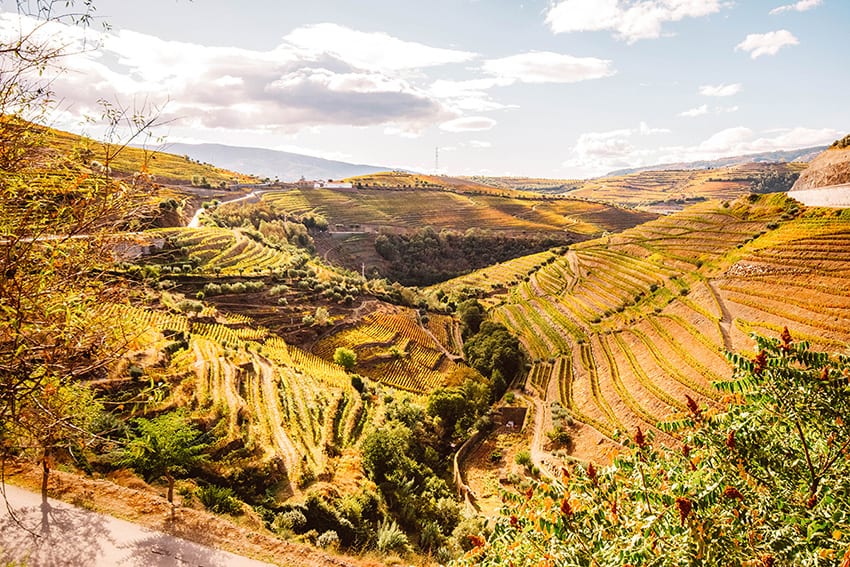
The Douro Valley in Northern Portugal is a dramatic and stunning landscape of rolling hills with terraced vineyards growing up the sides of the steep slopes. This incredible wine region became listed as a UNESCO heritage site in 2003. Wine production has been a part of the Douro Valley’s culture and heritage for the past 2,000 years making it the world’s oldest wine region. In fact, this is where the world-famous beverage Port was first invented and is still produced there today! Centuries of human activity have shaped these landscapes into the unique beauty that we see today. It was the process of traditional farming techniques that caused these steep terraces to form over the centuries.
A 1.5 hour drive inland from the coastal city of Porto will take you to the Douro Valley. The best way to visit is to either take a day trip from Porto or to drive through the area on a Portugal road trip. Organised tours depart daily from Porto as well as the option to take the train which connects Porto to the small villages in the hills of the Douro Valley. While you’re there, don’t miss out on taking a tour of one of the ancient wineries that are still in operation today. Learn the history behind this fascinating UNESCO heritage wine region while sampling the delicious wines and Ports and taking in the breath-taking scenery.
Bardejov, Slovakia
By Slavka from On2Continents

Nestled among the hills of the Beskydy Mountains, Bardejov is a picturesque medieval town in the north-east of Slovakia. In 2000, its historic value, particular architecture and intact historic core were recognized, and the town was included on the UNESCO World Heritage Sites list. Bardejov has been settled since the Stone Age, in 1376 it gained the status of a royal town and flourished as a busy trade town.
Today, Bardejov is a popular tourist destination for its well-preserved 13th-century Basilica of St. Aegidius, 16th-century Town Hall and the Gothic and Renaissance burghers’ houses that line the spacious main Town Hall Square. The medieval square also hosts the popular Bardejov Fair which takes place every year at the end of August. The history of this fair goes back to the 14th century and now it’s in its 670th season.
Bardejov is a great day trip destination. The must-do list includes exploring the Town Square and its many restaurants, coffee shops and boutiques; climbing the basilica bell tower which offers amazing views of the whole town and surrounding mountains; history lovers will enjoy visiting the old Town Hall that houses one of the oldest museums in Slovakia; walk along the fortification walls that date back to the 14th century and which belong to the best preserved and the most extensive medieval defence wall systems in Slovakia.
Besides exploring the town, visitors can enjoy the local open-air museum of folk architecture as well as the healing mineral waters of the nearby Bardejovske Kupele. Just a short drive north, the small spa town of Bardejovske Kupele offers many mineral springs with numerous therapeutic effects for digestive, circulatory and oncological problems. The spa town hosted famous rulers such as Napoleon Bonaparte’s wife Marie Louise, Duchess of Parma, Russian Tsar Alexander I and Empress Elisabeth of Austria-Hungary, known as Sissi.
Tombs of the Kings, Cyprus
by Emma from Wanderlust and Wet Wipes

Around two kilometres north of the ancient city of Paphos you’ll find the Tombs of the Kings. Set on a large site right on the coast, this large necropolis offers an opportunity to explore history against a stunning backdrop of stone (the tombs are cut into the native rock), the Cypriot coastline and a sparkling blue sea. They form part of the Archaeological Park of Kato Pafos (Paphos) which is one of the most important archaeological sites of Cyprus that has been a UNESCO World Heritage Site since 1980.
Not much is known about these underground tombs but it is believed that many of them date back to the Hellenistic and Roman periods (maybe as early as 3rdor 4thcentury BC and are carved out of solid rock. No kings are actually buried there, rather they are the burial sites of Paphitic aristocrats and high officials up to the third century AD. Concurrent with the period, they are designed to look like houses and some even have a grand atrium inside. The tombs were probably the victims of grave robbers who stole the riches inside them and, along with them, much of their history.
All the tombs are numbered and have an information plate next to them. They are all accessible by stone or wooden steps. There is also a museum where many of the more interesting and valuable excavated artefacts are housed. At the time of writing it costs EUR 2.50 to get into the Tombs of the Kings and it is open year-round (although it has different opening hours for winter/summer). Check the Visit Cyprus website for the most up-to-date information.
Grand Place, Brussels, Belgium
by Sophie from Everything Brussels
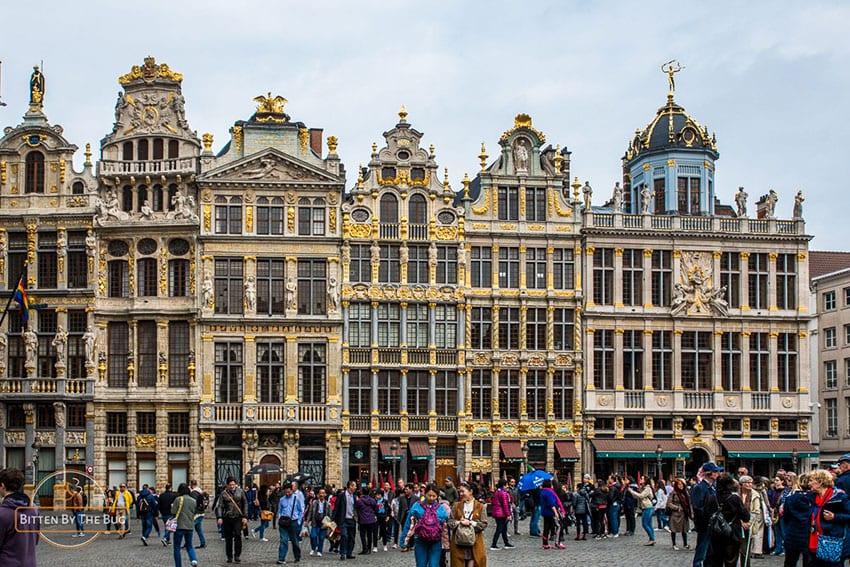
When talking about UNESCO World Heritage sites, Brussels isn’t the first place that usually comes to mind. Nevertheless, there are some amazing architectural gems that shouldn’t be missed. One of them is the Grand Place of Brussels, a large cobblestone square in the heart of Brussels which feels a bit like an open-air museum. It is surrounded by so many wonderful buildings that you don’t know where to look first.
The most prominent one featuring a large tower is the town hall of Brussels. This Gothic building was erected in the 15th century in different stages and by different architects. As a result, the town hall is completely asymmetric. Have a look and you’ll quickly spot the differences between its right and left wing.
Rumour says that when the town hall was finished and the architect realised the big flaws, he committed suicide by jumping off the tower. The place where he supposedly landed, is now marked with a star.
During the French bombardments of 1695, a big fire destructed large sections of the town hall. In the following years, the building underwent large renovations and was expanded with three extra wings.
On the opposite side of the square sits the ‘Maison du Roi’. In earlier times, it was a wooden building where bread was sold. Today, it houses the Museum of the City of Brussels which offers information about the history and folklore of the city.
The other buildings surrounding the square are former guild houses. Particular about them, is that you can guess the trades practised by the guilds from the details in the façade. The house which rooftop features a replica of a galleon’s stern, for example, belonged to the boatmen. In a similar way, you can easily identify the others as well.
YOU MIGHT ALSO LIKE: UNESCO Sites Off the Beaten Track – The Americas & Caribbean
Graz, Austria
by Jacky from Nomad Epicureans
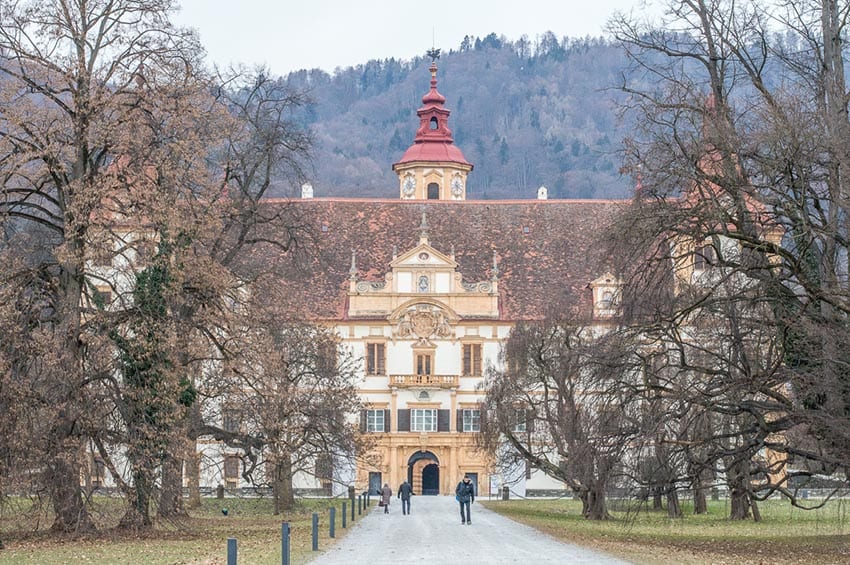
Although Austria is home to a number of UNESCO World Heritage Sites, one of the lesser-known yet most beautiful is the Old Town of Graz. Graz is Austria’s second-biggest city and can best be described as a true hidden gem. Despite its long history, thriving cultural scene, and architectural beauty, only few tourists decide to visit.
The city dates back to the 12th century and rose to an important economical hub under the Habsburg reign. Today, the Old Town of Graz bears witness to the splendour of the time. The Old Town is a harmonious mix of architectural styles which succeeded one another between the 12th and 18th centuries.
You can wander the streets for free and marvel at pieces such as the ‘painted house’ or you can climb the ‘Schlossberg’ and enjoy a view of the Old Town with its signature red roofs from above.
A second part of the UNESCO listing is Eggenberg Palace. This stunning palace combines imposing Baroque architecture with playful Rococo elements. Although some elements of the palace date back to the Middle Ages, it obtained its current shape in the 17th century. It features 24 staterooms, a gorgeous ballroom, also known as ‘Planetary Room’, as well as an expansive garden. In the summer, the staterooms can be visited on a guided tour costing 15 EUR.
And did you know that Graz is one of only two cities holding both, the UNESCO World Heritage title as well as the title UNESCO City of Design? Whatever you like to do, Graz won’t let you down!
Sanctuary of Asklepios at Epidaurus, Greece
by Stephanie from Sofia Adventures

While there are tons of famous day trips from Athens (like seeing Meteora, Delphi, and the islands near Athens), one of my favourites ended up being the UNESCO World Heritage Site of the Sanctuary of Asklepios at Epidaurus.
Asklepios was the Greek god of medicine, and the Sanctuary dedicated to him was an internationally important medical and healing centre beginning in the sixth century BC. The town became famous throughout the region, and people came from all over to convalesce and seek medical treatments.
While the center is famous primarily for being one of the most important ancient Greek sites, the city continued to be important long into the ancient Roman era.
While here, make sure to visit the small museum which houses artefacts from the city’s history. However, the real highlight here is the ancient Greek theatre. It is regarded as the best example of architecture and acoustics of all surviving ancient Greek theatres.
You can visit on your own from Athens utilising public transportation, or you can visit as a day trip from Athens. Most day trips will include a stop at another important ancient Greek UNESCO World Heritage site, the ancient Greek settlements of Mycenae and Tiryns!
Matera, Italy
by Laura from Travelers Universe

Matera is one of the most extraordinary places in Italy. It is a unique city in the region of Basilicata and you are guaranteed to be amazed by the complex of caves carved into the mountainside.
If you like caves, you are in luck, as most of your time here will be spent in caves — sleeping in a cave, dining in a cave, visiting museums in a cave… All this is possible in the Sassi of Matera due to the series of dwellings carved into the limestone. It makes the place totally different from everything that you have seen so far.
While you are there, mesmerized by the beauty of the city, you would never think that in the middle of the last century this very same place was evacuated due to poor living conditions. Of course, everything is different today. These ancient neighbourhoods are filled with life and there are lots of things to do in Matera.
Matera is best explored on foot, as you can get lost on purpose through the narrow alleyways that form a labyrinth of sorts. Eventually, its secrets will be revealed to you from places like small courtyards decorated with lots and lots of flower pots, to museums like the Casa Grotta di Vico Solitario or cave churches like the St. Lucia alle Malve with its 13th-century frescoes.
YOU MIGHT ALSO LIKE: UNESCO Sites Off the Beaten Track – Africa
Segovia Aqueduct, Spain
by Wendy from The Nomadic Vegan

The aqueduct in Segovia was built by the Romans nearly 2,000 years ago. Some say Emperor Augustus was responsible for its construction, while others say it was built under Trajan’s reign. Since there’s no inscription, it’s impossible to know for sure.
What we do know, though, is that it’s one of the best-preserved ancient Roman engineering works in the world and is still in use today. The aqueduct carries water 15 kilometres from the Frío River in the Sierra de Guadarrama mountains to the centre of Segovia.
There’s no entrance fee, as the aqueduct runs right through the centre of the city, and anyone can walk up to it and touch the pillars supporting its 167 arches.
The best viewpoint is probably Azoguejo square, where the aqueduct’s pillars are at their highest. Here you’ll also find a small Syrian restaurant called Tuma that offers fabulous views of the aqueduct, along with friendly service and delicious food. The menu includes plenty of veggie options, so it’s a great choice for vegan and vegetarian travelers in Spain.
The aqueduct has been recognised as a UNESCO World Heritage Site in Europe since 1985. Remarkably, no mortar or clamps were used to hold the massive granite blocks together, just the natural force of balance.
The UNESCO listing includes not just the aqueduct but also the Old Town of Segovia, which is well worth exploring while you’re here. Other sights in town that shouldn’t be missed include the Cathedral, the Alcázar and the Judería (Jewish quarter).
Merida, Spain
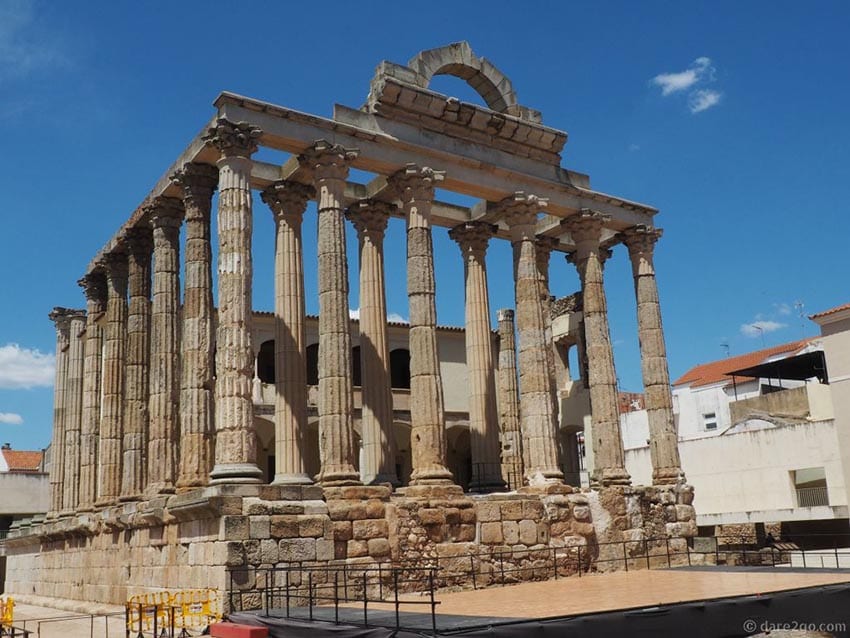
by Juergen from Dare 2 Go
In the far west of Spain, you will find the town of Merida, which has some of the best-preserved Roman ruins anywhere in Europe. Many of its World Heritage-listed Roman architecture dates back to just after 25 AD, the founding year of the Roman outpost as a retreat for its veteran soldiers.
This ancient “retirement village” received all of the conveniences and prestigious structures that a much larger Roman city offered its inhabitants at the time. Today’s Archaeological Ensemble of Merida consists of a Roman Theatre, an Amphitheatre, two Roman Bridges, two Roman Aqueducts, and several Roman Temples, all of which are very well preserved for their age.
Recent excavations have also unearthed the remains of a number of Villas; splendidly decorated houses of its former Roman citizens, which included beautifully detailed mosaic floors. At the edge of the old town there is also the remnants of a Circo Romano, a chariot racing circuit rivalling the size of the original in Rome.
Another highlight is the town’s large National Museum of Roman Art, a purpose-built modern complex to exhibit local archaeological finds. Otherwise, these artefacts would probably have been transferred to the National Museum in Madrid.
After the Romans retreated from Spain, the town was taken over by the Visigoths, whose reign was ended by the invading Moors from Northern Africa. These two nations made use of the Roman buildings and also left their own significant structures behind. For example, guarding the main Roman Bridge across the Guadiana River, are the imposing remains of an Arab Citadel.
The most pleasant thing about Merida are the facts:
- it’s not high on the tourist radar, so you’re never facing long lines or big crowds at the town’s interesting sights;
- it’s a quiet, relaxed place of only 60,000 inhabitants;
- the historic centre is so compact that most sights can easily be reached on foot.
Nevertheless, Merida is not really out of reach: it’s exactly 200 kilometres north of the popular destination of Seville. The area, including the border region of Portugal, has a good number of other worthy World Heritage Listed attractions – most are similarly interesting and quiet as Merida.
Villa Savoye, Poissy, France
by Elisa from World in Paris

Villa Savoye by Le Corbusier is perhaps the most iconic work of this famous architect. Le Corbusier, born in Switzerland, is considered the father of modern architecture which is based on 5 principles: the use of pilotis (stilts); free, open plan; free design of the façade, horizontal windows, the roof garden.
Villa Savoye, located in the city of Poissy, was built between 1928 – 1931 as a weekend home for the Savoye family, hence the name. The Savoye family gave the architect total freedom for the design. It is in Villa Savoye where we can see for the first time all the 5 principles of modern architecture applied.
The house is a wonder and a must for any architecture passionate. Despite its age, soon 100 years, the design of the house is so interesting and modern that it could be perfect for any family today. Le Corbusier fans will find in this house other interesting features that the architect will use later in other works. The house has today few pieces of furniture but visitors can see some of Le Corbusier’s most iconic pieces such as the chaise longue.
Villa Savoye, inscribed in the Unesco World Heritage list since 2016, is very easy to reach from Paris on a half-day trip. From Paris, it is a half-hour ride by RER A train to Poissy train station. At the exit of the train station, the buses bus #50, 51 or #55 take visitors to the villa in only 7 minutes. Currently, the ticket costs 8€ but it is free for people under 18.
YOU MIGHT ALSO LIKE: UNESCO Sites Off the Beaten Track – The Middle East
Etruscan Necropolises, Cerveteri, Italy
by Annalisa from Travel Connect Experience

One of the hottest debates among Italian archaeologists has been trying to answer the question of whether the communities which settled in Italy thousands of years ago came from the continent of from the sea. Recent findings on the islands and in the coastal areas of the Mediterranean Sea seem to endorse the latter hypothesis.
The Etruscans were a peaceful, advanced, matriarchal civilization which flourished in Central Italy long before the Romans carried out their plan of conquest on and beyond the Italian Peninsula. The massive, mysterious remains of the Etruscans concentrate particularly on the Tyrrhenian coast and resemble, in shape and function, other incredibly numerous ruins found in the coastal regions of the Mediterranean Sea and in Asia Minor.
The Etruscans seemed to hold a very special interest in water, stone, and the afterlife. One of their most important necropolises, in terms of dimension and preservation, lies at a few km from the coast of the Lazio region and can be reached easily on a day trip from Rome. The site is known as “Necropoli della Banditaccia” and became a Unesco Heritage in 2004.
It consists of thousands of tombs linked by a 2 km long “sacred path.” The tombs that stand out are tumuli reproducing the houses of the wealthy families who built them. The site is never crowded and the visit can become a fascinating exploration in the shade of pine trees.
The ticket for adults costs €8 and includes a guided walk of about one hour with a multimedia reconstruction inside one of the biggest tombs. After the guided tour ends, feel free to spend the day walking across the sleepy city and examining the site, as 400 tombs have been restored and are accessible.
I hope you enjoyed this trip around some of the more unusual UNESCO Sites in Europe, look out for my posts on Asian, African, American and Middle Eastern UNESCO Sites.
Don’t forget to pin this article so you can come back to it later
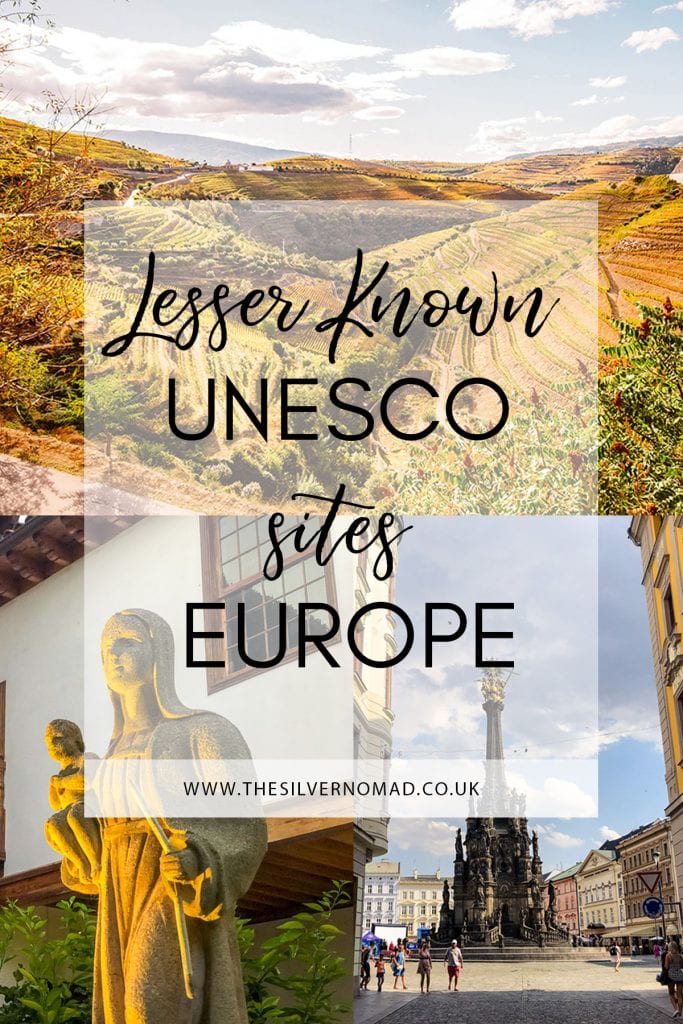
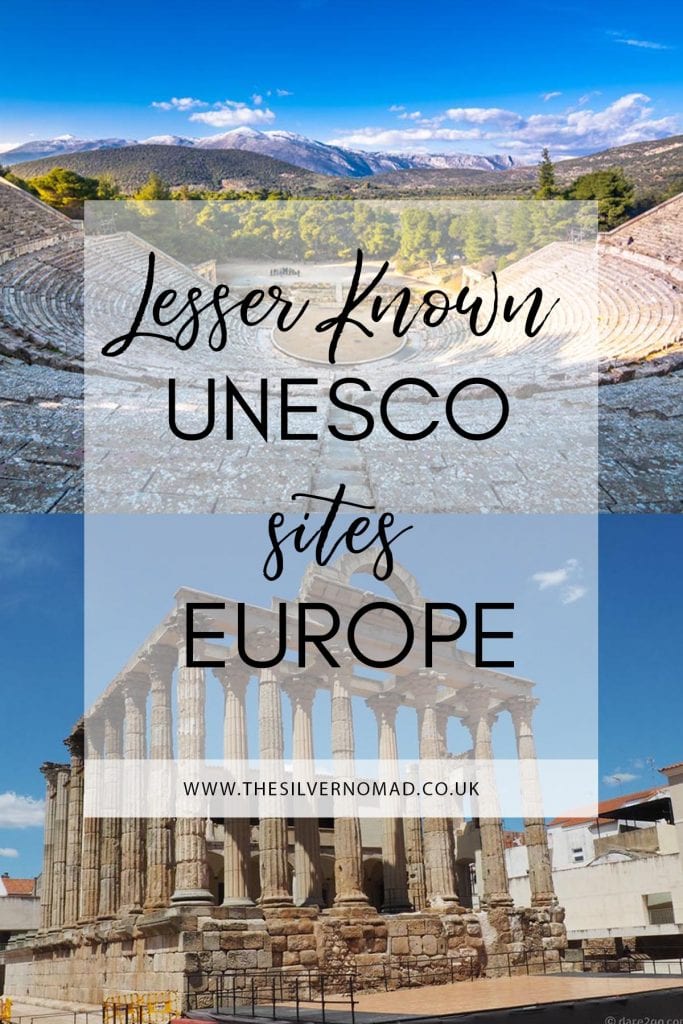

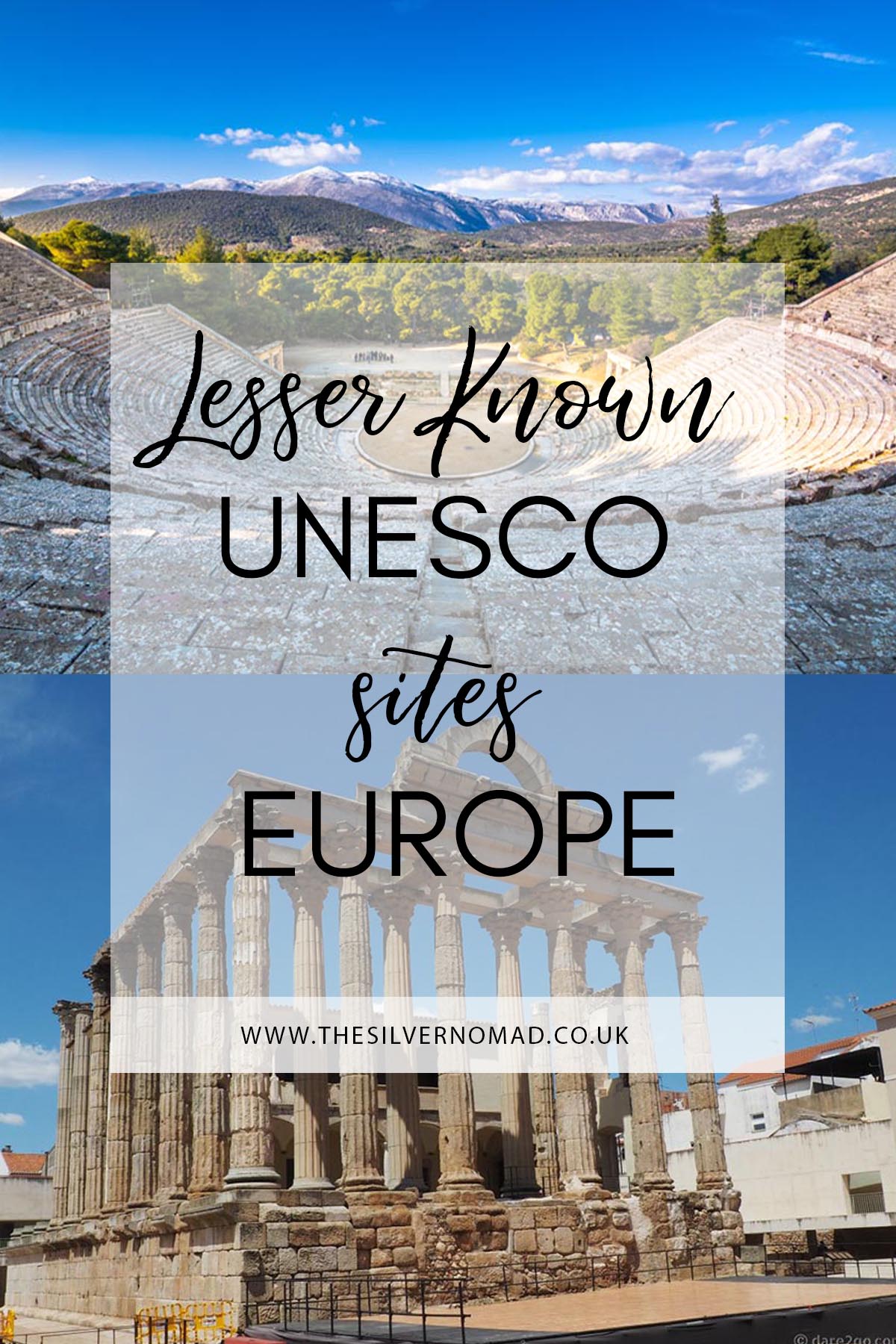

Excellent list. I have been to several places and plant to visit many others you mentioned here.
Fantastic to hear you have been to some of the places Slavka.
So many places, so little time! Of all UNESCO World Heritage Sites listed here, I am inclined to travel to Georgia – it has a different kind of beauty.
Georgia is on my list for next year, there seems like a haunting beauty there that I want to explore
Couldn’t wait for this Unesco sites off the beaten track article
I didn’t know most of them, now I want to tick them all off my bucket list!
Fantastic Annalisa, can’t wait to see what you think of them!
I love a lot of these, but many I haven’t heard of! Great list!!
Thank you Mona, hope you get to see some of them!
I love heading off the beaten track on travels. A really great selection there Larch
Thank you Sima, some amazing places to explore!
What a great post and beautiful photos! I love finding the lesser known areas and this would be a go to for future Europe travel plans!
Thank you Lauren, look out for my posts on UNESCO sites in Asia, America and Africa!
I have been to Nessebar this summer and its absolutly beautiful
I haven’t been to Nessebar yet, but it is on my list when I visit Bulgaria next year.
I always forget how many awesome UNESCO sites are in Europe. I’ve been to tons internationally, but only one on this list, Segovia, which is awesome!. I better get planning my trips for next spring and summer to tick a few more of these off. I’m feeling really spoilt for choice now though.
I totally agree Becki, so many more have been added to my list for next year!